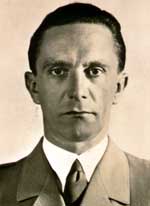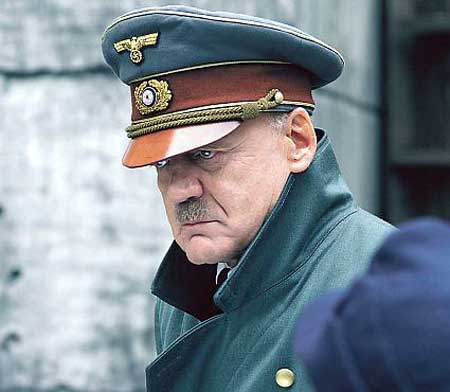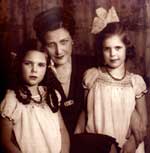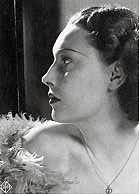 I
was taken aback by the two figures
selected by scriptwriter Bernd Eichinger
for "good guy" treatment in the
script.
I
was taken aback by the two figures
selected by scriptwriter Bernd Eichinger
for "good guy" treatment in the
script.
|

January
31, 2005 (Monday)
London
(England) 5:45 PM TAXI to Soho Square to the studios of
Twentieth Century Fox, for a private viewing of
Downfall, Der Untergang -- the new German
film of Hitler's last days. Lady Michele
accompanies me. The movie theatre is packed, and I
notice four staff members from Wiener Library have
signed in ahead of me in the guest book. I wonder
what they make of the film. I know what C C
Aronsfeld would have thought! I must say that after all the hoopla in the
German media, I am disappointed. From the opening
title of Constantin Film Verleih, worse than the
clumsiest that Ufa could produce, to the closing
sequence -- pictures of the actors, with
where-are-they-now biographies of the real
characters, the film was unbelievably clunky and
amateurish in parts. The German producers did not
stoop to Steven Spielberg's trick of making
it in black and white ("to provide documentary
footage for the future", as the chief camera
director of Schindler's List disingenuously
told his trade journal Der Kameramann); the
colour in Downfall is washed-out, low key,
Berlin-grim.  The
actors are sometimes easy to identify -- for us
Nazi experts anyway -- by the uniform they are
wearing, and sometimes not; Dr Joseph
Goebbels is far too big to be the Little
Doctor, but he is evidently chosen for his ability
to mimic the propaganda minister's superb Rhineland
elocution, and at times he does so with chilling
verisimilitude. The
actors are sometimes easy to identify -- for us
Nazi experts anyway -- by the uniform they are
wearing, and sometimes not; Dr Joseph
Goebbels is far too big to be the Little
Doctor, but he is evidently chosen for his ability
to mimic the propaganda minister's superb Rhineland
elocution, and at times he does so with chilling
verisimilitude.
- A corpulent army general is identified to us
only in the closing titles as having been
Alfred Jodl, hanged at Nuremberg; we
would never have guessed -- the real Jodl was a
wiry, balding, and spare-framed
mountain-artillery officer.
- Martin Bormann, the same: fat,
perspiring, unhealthy in the film, in reality
burly, muscular, slicked haired, and
scowling.
- Otto Günsche, Hitler's long-time
SS adjutant, we would never have recognized from
the tall handsome dark-haired officer in the
film; the real Günsche, who provided to me
in the 1960s the first hand narrative on how
Hitler and Eva Braun took their own
lives, and the dialogue between them which
mysteriously turns up verbatim in this film
script, was burly, Aryan, and blonde.
 - In the film Walther Hewel,
Ribbentrop's liaison officer to Hitler, is a
thin, nervous, weedy, pharmacy-clerk type of
man; in reality (see my picture from his
files: he is at far right, with Heydrich,
centre, and Julius Schaub) he was a broad
shouldered, suave, dark-haired diplomat, a
handsome lady's man -- the only top Nazi to have
seen the outside world, having spent twelve
years of his life as a rubber planter in
Java.
 HAVING said that, I can say what saves this film
and elevates it into a stellar category are the
spectacular and deeply human portrayal by Bruno
Ganz (below) of the aging and defeated Adolf
Hitler -- he has perfected the guttural
Austrian accent down to the last rolling rrrrr; and
the warm, affectionate portrayal of his secretary
from 1942 to the end, Traudl Junge. She is
played by a Transylvanian-born actress of great
feminity and beauty, with moist, limpid eyes that
are able eloquently to convey her feelings, for
example the delicate disgust when Goebbels dictates
his final will, emphasizing the purity and
unblemished (makellos) character of his
actions, before turning away to mastermind the
murder of his six children.
HAVING said that, I can say what saves this film
and elevates it into a stellar category are the
spectacular and deeply human portrayal by Bruno
Ganz (below) of the aging and defeated Adolf
Hitler -- he has perfected the guttural
Austrian accent down to the last rolling rrrrr; and
the warm, affectionate portrayal of his secretary
from 1942 to the end, Traudl Junge. She is
played by a Transylvanian-born actress of great
feminity and beauty, with moist, limpid eyes that
are able eloquently to convey her feelings, for
example the delicate disgust when Goebbels dictates
his final will, emphasizing the purity and
unblemished (makellos) character of his
actions, before turning away to mastermind the
murder of his six children.
 This is the one scene which does bring a tear to
my eyes, I confess, even though the script falsely
has Dr Ludwig Stumpfegger administering a
sleeping draught to the reluctant infants, whereas
they were in fact anesthetized with a morphine
injection by the SS dentist in the bunker; when
they were sound asleep their mother Magda crushed a
glass a cyanide ampoule in each tiny mouth using a
pair of pliers.  Magda
here is a departure from reality; she is played as
a cunning, fiendish, Machiavellian, raven-haired
and slender female displaying all the warmth and
maternal charm of the evil "Mrs Danvers" in
Alfred Hitchcock's Rebecca; I do know
real women who are like that, but in reality Magda
Goebbels (right, with her two oldest
daughters) was a simple, charming, feminine
woman, once platinum-blonde, whose comeliness as a
female was a not lessened by having borne six
children. She had once dated
Chaim Arlosoroff, a Zionist fanatic
later assassinated in Palestine, and her step
father (and I believe real father) Robert
Friedländer was Jewish (and met his end
like many other Jews as a dehumanized prisoner
in
the concentration camp at Buchenwald). Magda
here is a departure from reality; she is played as
a cunning, fiendish, Machiavellian, raven-haired
and slender female displaying all the warmth and
maternal charm of the evil "Mrs Danvers" in
Alfred Hitchcock's Rebecca; I do know
real women who are like that, but in reality Magda
Goebbels (right, with her two oldest
daughters) was a simple, charming, feminine
woman, once platinum-blonde, whose comeliness as a
female was a not lessened by having borne six
children. She had once dated
Chaim Arlosoroff, a Zionist fanatic
later assassinated in Palestine, and her step
father (and I believe real father) Robert
Friedländer was Jewish (and met his end
like many other Jews as a dehumanized prisoner
in
the concentration camp at Buchenwald).
 I WAS taken aback by the two figures selected by
scriptwriter Bernd Eichinger for "good guy"
treatment in the script. One is Professor Dr Dr
Ernst-Günther Schenck; I interviewed
him many times in the 1970s and obtained from him
the graphic descriptions and dialogues of the last
two days in the bunker -- which now strangely turn
up, unchanged, in this film's script. Note that in
the German façon, having won two doctorates,
he sported both Dr's in his title. He headed an SS
branch on nutritional medicine, and there are the
inevitable allegations against him as an SS
doctor.
I WAS taken aback by the two figures selected by
scriptwriter Bernd Eichinger for "good guy"
treatment in the script. One is Professor Dr Dr
Ernst-Günther Schenck; I interviewed
him many times in the 1970s and obtained from him
the graphic descriptions and dialogues of the last
two days in the bunker -- which now strangely turn
up, unchanged, in this film's script. Note that in
the German façon, having won two doctorates,
he sported both Dr's in his title. He headed an SS
branch on nutritional medicine, and there are the
inevitable allegations against him as an SS
doctor.
In this film however Schenck is an unquestioned
moralising hero, as is a far darker figure,
Hermann Fegelein. The real Hermann Fegelein
was a murderous, womanizing, power-hungry SS
cavalry officer -- I interviewed his brother
Waldemar once -- who married Eva Braun's
slightly sluttish sister Gretl, and was shot
for desertion in the last days of the war. Eva
incidentally was about ten years younger than the
actress in this film. He was found in his apartment
in Berlin, in civilian clothes, planning to flee,
with a belt of gold coins to facilitate his flight;
as well he might, for an Allied gallows would
certainly have awaited this officer, whose 1st SS
Cavalry Division of horseback huntsmen conducted a
ruthless war against Partisans and their
accomplices -- and we historians all know what that
means -- in the occupied eastern territories. His adjutant, the late Johannes
Göhler, an upstanding Waffen SS officer,
was a good source of mine and provided to me a
sheaf of his private letters written from Hitler's
HQ from August 1944 to the end. Fegelein's fate,
shot for desertion, is well documented. The film
shows Hitler however virtually foaming at the mouth
as he demands this execution. Not so: - first, Hitler's adjutants assured me that he
did not foam, even metaphorically, but was
always calm and measured in his elocution
(except for the one occasion, April 22, 1945,
when he did suffer a dramatic breakdown on
hearing of the failure of military operations
for the relief of Berlin); and
- second, Otto Günsche told me that it
was he personally who had gone to Hitler and
advised him that he and the other adjutants,
hearing that the Chief was minded to show
clemency, were demanding that Fegelein be stood
before a firing squad for his cowardice.
There are loose ends left unexplained in the
film. General Hans Krebs is shown at the
end, negotiating with Marshal Zhukov's
officers and speaking fluent Russian; left as it
is, it gives the impression that he may have been a
Soviet traitor in Hitler's headquarters. In fact he
spoke fluent Russian having been military
attaché in Moscow until Barbarossa began in
June 1941. We are not told why the secretary Traudl Humps'
name changes in mid-film to Traudl Junge. She had
married Hitler's Ordonnanz, SS
Hauptsturmführer Wolf Junge, but the
wartime marriage did not last long. She described
to me how in June 1944 "the Chief" (wrongly
translated as Führer, several times, in the
sub-titles) had sent for her, tears in his eyes,
taken both her hands in his, and said, "Ach,
mein Kind, I am so sorry" -- and broken to her
the news that Wolf had just been killed in action
in the Normandy fighting.  ALTHOUGH the "consultant" credited in the titles is
a certain Joachim Fest, well-known German TV
presenter and personality and author, I suspect
that my own name might by rights have been there in
the titles too. As my readers will recognize
immediately, at least fifty percent of the dialogue
has been lifted straight out of my book Hitler's
War (first published in Germany in 1975),
and much of the rest from my Joseph
Goebbels biography too!
ALTHOUGH the "consultant" credited in the titles is
a certain Joachim Fest, well-known German TV
presenter and personality and author, I suspect
that my own name might by rights have been there in
the titles too. As my readers will recognize
immediately, at least fifty percent of the dialogue
has been lifted straight out of my book Hitler's
War (first published in Germany in 1975),
and much of the rest from my Joseph
Goebbels biography too!
There is nothing new or even unusual about this.
Fest is not an author well known for original
research but, as they say, using just one book is
plagiarism; using two is investigation; while using
three or more is deep, profound, original, and
overwhelming in-depth research. Several times, as a scene was set up in this
film, I found that I knew precisely what was going
to come next; once, the screen fills with Hitler
handing out cyanide capsules to his staff, standing
dutifully in line as though at a Christmas
reception, and he reaches Traudl. I turn to Lady M,
and recite: "I am so sorry that I can offer you
nothing better than this." And there is that very
line on the screen. I am sorry too -- sorry to see that the film
makers have done to Traudl what they did to Lida
Baarova (Goebbels' girlfriend, right) in
her Westdeutscher Rundfunk television interview
about him: they required the latter female to come
back on screen and gently grovel (but Lida cleverly
changes her dress for this final shot, so that
future cognoscenti can recognize what has
happened). So here too, after the Hitler film ends, it
produces the real Traudl Junge, now in her late
80s, wrinkled and with her once-fair complexion
pocked and blemished by the imminent onset of
death, and she apologises for not having seen how
wicked her Chief, Adolf Hitler, really was. At one point in this toe-curling postscript her
memorized lines make her say that she has recently
realized, walking past the memorial tablet for
Sophie Scholl -- one of the student traitors
in Munich -- that Sophie was the same age as she,
and had been executed on the same day that she was
being interviewed by Hitler for her job as a
secretary. But that cannot have been so, because
her job interview was in November 1942, as the film
also makes plain at the beginning; and the Scholl
sisters were executed in 1943 -- in March, if
memory serves. But even here something of the real
Traudl tweaks through. She says that had she known
what was going on . . . to the Jews
. . . then, of course . . . but
she never heard even a murmur of that while working
next to Hitler. At Hitler's headquarters! At Hitler's side:
present at his conference table, and at his table
talks: throughout the remaining months of the war,
from Stalingrad onwards, literally to the very end:
never heard a murmur about what since the 1970s is
called The Holocaust. Now what can that
portend? That is a real conundrum, which may or may not
sink in with the movie-goers. All of Hitler's
staff, including his surviving verbatim conference
stenographers, confirmed this to me -- that nothing
was ever said or known about it at Hitler's HQ --
as did Richard Schulze, his personal SS
adjutant, when I invited him to attend a live David
Frost TV program devoted to my Hitler biography on
June 9, 1977); just as Hitler's personal staff had
all told the American and British interrogators
shortly after the war, at a time when to say
otherwise would certainly have earned them favours,
like a transfer from the criminal wing to the
privileged witness wing at Nuremberg.
Kurzum: Not a word of the atrocities
filtered back into Hitler's "monastery-like"
headquarters.  SOME of the scenes in this film are breathtaking,
almost religious tableaux, constructed to the
nearest millimetre from the surviving photos:
SOME of the scenes in this film are breathtaking,
almost religious tableaux, constructed to the
nearest millimetre from the surviving photos:
- Hitler ten days before the end handing out
Iron Crosses to schoolboy-age Hitler Youths for
heroism against the Soviet tanks.
- Hitler emerging briefly from the ruined
bunker to the garden, surrounded by his staff (a
photograph actually taken after a British air
raid in November 1943, according to Julius
Schaub, not in April 1945).
There are some minor flaws. History shows that
Hitler orders the thirty or so nurses brought in to
his bunker from the next-door Voss Street bunker,
which has been turned into an emergency hospital,
to decorate and commend them for their courage in
tending the injured. Schenck described the scene to
me -- and here it is, like magic, in Bernd
Eichinger's film -- but there is only one nurse
here, the one who sinks in hysterics to the ground
and clutches Hitler's knees and implores him to
leave Berlin. Economising on extras? Another tiny flaw: I would swear that the exit
staircase from the bunker was a
Wendeltreppe, a spiral staircase, not the
square concrete staircase shown in the film. Otto
Günsche told me how awkward he had found it to
carry the cyanide-reeking body of Eva Braun up the
spiral to the garden. But Winston Ramsay,
editor-in-chief of After the Battle, has
also attended the screening, and he has actually
visited the ruins, and he tells me over a modest
supper in Soho afterwards that he thinks that
"square" is right, not spiral.  UNIMPORTANT? But there are also major excesses and
distortions. The bacchanalian scenes and orgies --
routine in such narratives now -- are fiction. Not
a cigarette was lit in the Bunker until Hitler was
dead. The drinking did begun, but it was
necessarily discreet. I cannot credit at all one
final scene, showing General Helmut
Weidling, the city's Kampfkommandant,
driving round Berlin in a loudspeaker van roaring
that Hitler has committed suicide and betrayed his
men. On the contrary, Grand Admiral Karl
Dönitz and the German people were told
that "the Führer has fallen in action,
defending the Reich capital."
UNIMPORTANT? But there are also major excesses and
distortions. The bacchanalian scenes and orgies --
routine in such narratives now -- are fiction. Not
a cigarette was lit in the Bunker until Hitler was
dead. The drinking did begun, but it was
necessarily discreet. I cannot credit at all one
final scene, showing General Helmut
Weidling, the city's Kampfkommandant,
driving round Berlin in a loudspeaker van roaring
that Hitler has committed suicide and betrayed his
men. On the contrary, Grand Admiral Karl
Dönitz and the German people were told
that "the Führer has fallen in action,
defending the Reich capital."
The corresponding radio announcement on May 1,
1945 was actually made by the late Jochen
Piechocki, Vertreter der SS im RmfVuP,
later better known as Jochen von Lang, my
friend the capable Stern researcher who
discovered the remains of Martin Bormann and
Dr Stumpfegger beneath a Berlin street in the
1970s: "Our Führer, Adolf Hitler, has fallen
in battle while fighting to the last breath
[bis zum letzen Atemzug]." What is remarkable is that the Adolf Hitler
masterfully portrayed in this film is allowed on
three or four occasions to deliver compelling
National Socialist propaganda speeches to his
audience which, I estimate, will not be without
effect on ordinary Germans (to borrow Professor
Christopher Browning's eloquent phrase). The real National Socialism was not what it had
become by 1945. It was something else, purer,
infinitely less criminal, and infinitely more
idealistic. Hitler's personal adjutant
Alwin-Broder Albrecht wrote this in his last
letter (his widow showed it to me), before storming
out of the Chancellery building after the Chief's
death with a blazing sub-machine gun in his hands,
and going down in a hail of Russian bullets. Hitler
too makes plain his regrets about this deviation
from his original National Socialist ideal, in
brief monologues in the film. So my verdict on the film is this: Must Try
Harder. Downfall is a good attempt, and
great entertainment if you like that sort of thing;
not a tear-jerker (like Hitler's War, according to
my friend David Kahn) but an innovational
film. It has brilliant, indeed intimidating,
all-around sound effects of the Battle for Berlin,
and wonderful and accurate portrayals of both
Hitler and his secretary Traudl Junge; but a jerky,
wooden script, which takes liberties with history
and the real characters. There are too many
helpings of p.c. and of undiluted Schlock; too much
Hitlerjunge Quex (the prewar non-Goebbels
movie, in which the grand music of the Horst Wessel
Lied swells from the screen as the film's young
hero, mercilessly beaten by communists, dies giving
the Hitler salute). Stephen Spielberg would have done it
better.
Dinner, as said, with Winston Ramsey. He knows
the exact spot where Heinrich Himmler's body
is interred on the Lüneburg Heath, and
revisited it some years back with the two War
Office people who originally buried it; but he has
refused to reveal it to anybody and I do not press
him. He also has Himmler's suitcase, and he knows
who has his eye glasses. All Himmler's personal
property, he says, was divided up among the British
troops as souvenirs at the time of his arrest. I
ask who has his 1945 Taschenkalender (pocket diary)
-- Ramsey does not know. M. has spent the afternoon with four rabbis,
interviewing them about Palestine, and constantly
wants to talk about this event; I find the Jews
tedious and boring, and successfully silence
her. Back home at 10:50 pm. The apartment is in
silence, as they are both asleep. [Previous
Radical's Diary] 
 Hitler
portrait tops box office in Germany
Hitler
portrait tops box office in Germany Two
new films show that Germans are learning to
confront Hitler's legacy | Germany
breaks the Hitler taboo | Media
angst over Hitler hype | Sympathetic
film portrayal of Hitler leaves Germans
baffled | BBC
reports Germans flock to see Hitler film |
Critics
pan Hitler movie as 'worst comedy of the
year'
Two
new films show that Germans are learning to
confront Hitler's legacy | Germany
breaks the Hitler taboo | Media
angst over Hitler hype | Sympathetic
film portrayal of Hitler leaves Germans
baffled | BBC
reports Germans flock to see Hitler film |
Critics
pan Hitler movie as 'worst comedy of the
year' Wie
Hitlers Antisemitismus schließlich zur
Judenvernichtung führte | Mommsen's
moral cowardice on display
Wie
Hitlers Antisemitismus schließlich zur
Judenvernichtung führte | Mommsen's
moral cowardice on display-
 Our big
Adolf Hitler file
Our big
Adolf Hitler file
|